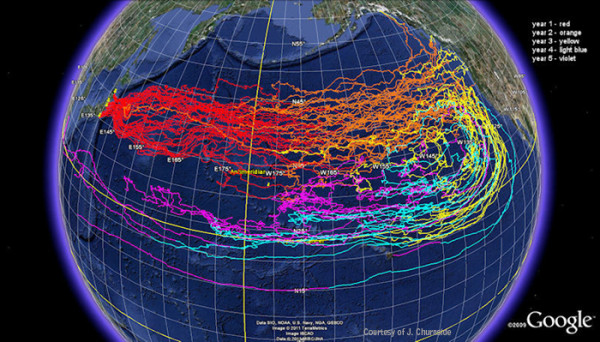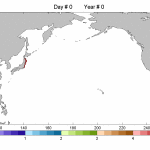
Debris from the 2011 Japanese tsunami is headed towards Hawaii and the North American west coast. For those concerned, several new sources of information are now available on the web:
Explainers: NOAA has a new video and podcast explaining how the debris is moving across the ocean, and what you can do to help. (Click through – it can’t embed). Ocean Conservancy also has a really nice explainer webpage. Though this isn’t new, the NOAA Marine Debris program also has a tsunami FAQ page.
NOAA visualization of debris track: Here is a visualization of the possible debris track from the NOAA Environmental Visualization Laboratory. (Again, you must click through, sorry.) It is based off 5 years of historical weather patterns, and is an approximation of a path the debris may take. For another look at possible debris paths, see my post on how scientists tracked tsunami debris to 700 miles off Midway Island.
Webinar: Japanese Tsunami Marine Debris: Anticipating and Mitigating Its Impacts on the Northwestern Hawaiian Islands. This webinar took place last Monday, and a video is now available for those who couldn’t catch it live. You can also see my tweets at @seaplexscience. If you are interested in more events of this type, sign up for the MarineDebris.Info listserv.
National Geographic story on tourists paying to go on an expedition to hunt for the debris field with the NGOs Algalita Marine Research Foundation and 5 Gyres.
Transpacific Tsunami Debris Presentation by Dr. Curtis Ebbesmeyer and Jim Ingraham. Dr. Ebbesmeyer is the physical oceanographer famed for tracking rubber duckies and Nike sneakers across the world’s oceans, and Jim Ingraham is a retired NOAA oceanographer who developed the Ocean Surface CURrent Simulator (OSCURS) model. (The OSCURS model is the basis for the debris path models linked to above.) The presentation was given at Peninsula College (Port Angeles, WA) on December, 13th 2011 and sponsored by Peninsula College, Coastal Watershed Institute and the Olympic Peninsula Chapter of Surfrider Foundation.






Fascinating information, and I’ll run the presentation later. One question, though – none of the articles gives a clear picture of what to do when you find human remains. It’s going to happen – bodies swept into the sea and tangled up with debris from Krakatoa were washed ashore in Zanzibar over a year later.
I’m assuming that after a year being exposed to the elements will leave not much more than a skeleton, but it would be useful if the Hawaiian and West Coast authorities could publish a procedure for locals to follow should they find any.